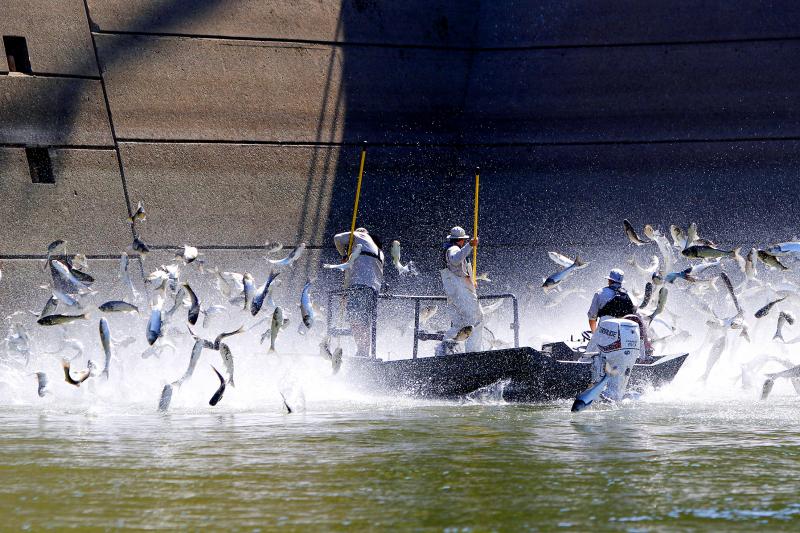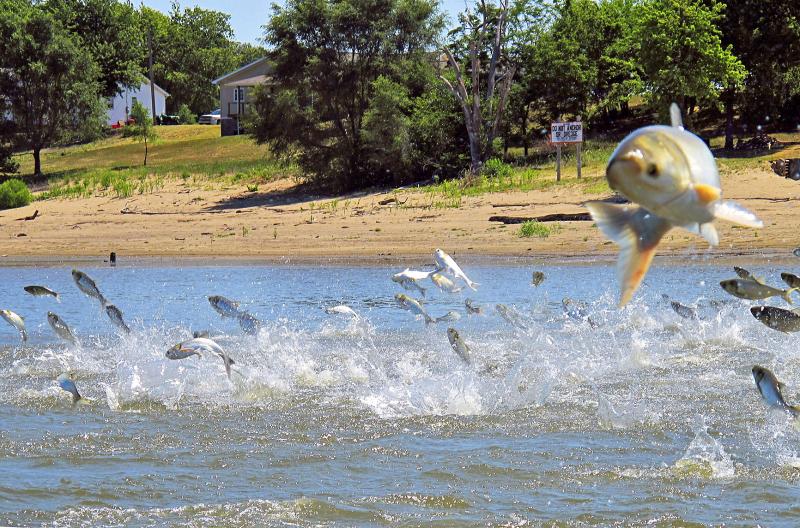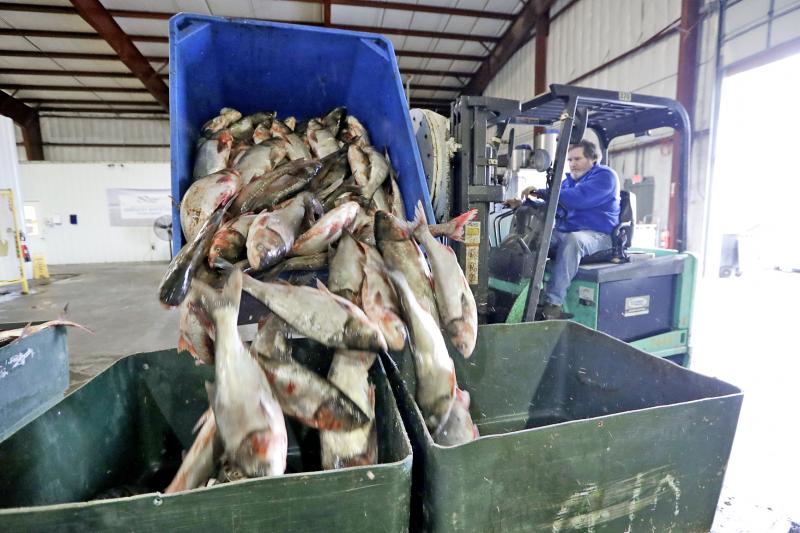You’re in the mood for fish and your server suggests a dish of invasive carp. Ugh, you might say. But how about broiled copi, fresh from the Mississippi River?
Here’s the catch: They’re the same thing.
Illinois and partner organizations kicked off a market-tested campaign Wednesday to rechristen as “copi” four species previously known collectively as Asian carp, hoping the new label will make them more attractive to US consumers.

Photo: AP
Turning carp into a popular household and restaurant menu item is one way officials hope to rein in a decades-old invasion threatening native fish, mussels and aquatic plants in the Mississippi and other Midwestern rivers, as well as the Great Lakes.
“The ‘carp’ name is so harsh that people won’t even try it,” said Kevin Irons, assistant fisheries chief with the Illinois Department of Natural Resources. “But it’s healthy, clean and it really tastes pretty darn good.”
The federal Great Lakes Restoration Initiative is funding the five-year, US$600,000 project to rebrand the carp and make them widely available. More than two dozen distributors, processors, restaurants and retailers have signed on. Most are in Illinois, but some deliver to multiple states or nationwide.

Photo: AP
“This could be a tremendous breakthrough,” said John Goss, who led the Obama administration’s effort to halt the carp invasion and worked on the renaming project. “The next couple of years are very critical for building confidence and acceptance.”
Span, a Chicago communications design company, came up with “copi.” It’s an abbreviated wordplay on “copious” — a reference to the booming populations of bighead, silver, grass and black carp in the US heartland.
Imported from Asia in the 1960s-70s to gobble algae from Deep South sewage lagoons and fish farms, they escaped into the Mississippi. They’ve infested most of the river and many tributaries, crowding out native species like bass and crappie.

Photo: AP
Regulators have spent more than US$600 million to keep them from the Great Lakes and waters such as Lake Barkley on the Kentucky-Tennessee line. Strategies include placing electric barriers at choke points and hiring crews to harvest the fish for products such as fertilizer and pet food. Other technologies — underwater noisemakers, air bubble curtains — are in the works.
It would help if more people ate the critters, which are popular in other countries. Officials estimate up to 22.7 million kilograms could be netted annually in the Illinois River between the Mississippi and Lake Michigan. Even more are available from the Midwest to the Gulf Coast.
“Government subsidies alone will not end this war,” Goss said. “Private-sector, market-driven demand for copi could be our best hope.”
In the US, carp are known primarily as muddy-tasting bottom feeders. Bighead and silver carp, the primary targets of the “copi” campaign, live higher in the water column, feeding on algae and plankton. Grass carp eat aquatic plants, while black carp prefer mussels and snails. All four are high in omega-3 fatty acids and low in mercury and other contaminants, Irons said.
“It has a nice, mild flavor ... a pleasant surprise that should help fix its reputation,” said Brian Jupiter, a Chicago chef who plans to offer a copi po’boy sandwich at his Ina Mae Tavern. The fish is adaptable to numerous cuisines including Cajun, Asian and Latin, he said.
Yet it could be a hard sell, particularly because the fish’s notorious boniness makes it challenging to produce fillets many diners expect, Jupiter added. Some of the best recipes may use chopped or ground copi, he said.
Dirk and Terry Fucik, owners of Dirk’s Fish and Gourmet Shop in Chicago, said they’ve sold carp burgers for years and offer carp meatballs, tacos and other dishes.
Span researchers considered many names — “butterfin” among them — before settling on “copi,” Irons said. It sounded catchy, a tad exotic, even fun, he said.
Span conducted surveys, interviews and focus group meetings with more than 350 Illinois residents, design principal Nick Adam said.
Next step: Seeking approval from the federal Food and Drug Administration, which says “coined or fanciful” fish labels can be used if not misleading or confusing. A familiar example is “slimehead,” which became a hit after its market moniker was switched to “orange roughy.”
Illinois also plans to register the “copi” trademark, enabling industry groups to develop quality control procedures, Irons said.
Other regulatory agencies and scientific groups have their own policies and might not make the switch.
The American Society of Ichthyologists and Herpetologists and the American Fisheries Society have a committee that lists fish titles, including scientific names in Latin and long-accepted common names. The panel never adopted “Asian carp” as an umbrella term for the invasive species.
The US Fish and Wildlife Service plans to stick with “invasive carp” and the four individual names, as its focus is on managing and controlling their spread, said Charlie Wooley, Midwest director. The Invasive Carp Regional Coordinating Committee, which involves numerous federal, state, local and Canadian provincial agencies, will do likewise.
They dropped “Asian carp” last year because of concern about anti-Asian bigotry.

Late last month Philippines Foreign Affairs Secretary Theresa Lazaro told the Philippine Senate that the nation has sufficient funds to evacuate the nearly 170,000 Filipino residents in Taiwan, 84 percent of whom are migrant workers, in the event of war. Agencies have been exploring evacuation scenarios since early this year, she said. She also observed that since the Philippines has only limited ships, the government is consulting security agencies for alternatives. Filipinos are a distant third in overall migrant worker population. Indonesia has over 248,000 workers, followed by roughly 240,000 Vietnamese. It should be noted that there are another 170,000

Enter the Dragon 13 will bring Taiwan’s first taste of Dirty Boxing Sunday at Taipei Gymnasium, one highlight of a mixed-rules card blending new formats with traditional MMA. The undercard starts at 10:30am, with the main card beginning at 4pm. Tickets are NT$1,200. Dirty Boxing is a US-born ruleset popularized by fighters Mike Perry and Jon Jones as an alternative to boxing. The format has gained traction overseas, with its inaugural championship streamed free to millions on YouTube, Facebook and Instagram. Taiwan’s version allows punches and elbows with clinch striking, but bans kicks, knees and takedowns. The rules are stricter than the

“Far from being a rock or island … it turns out that the best metaphor to describe the human body is ‘sponge.’ We’re permeable,” write Rick Smith and Bruce Lourie in their book Slow Death By Rubber Duck: The Secret Danger of Everyday Things. While the permeability of our cells is key to being alive, it also means we absorb more potentially harmful substances than we realize. Studies have found a number of chemical residues in human breast milk, urine and water systems. Many of them are endocrine disruptors, which can interfere with the body’s natural hormones. “They can mimic, block

Pratas Island, or Dongsha (東沙群島) had lain off the southern coast of China for thousands of years with no one claiming it until 1908, when a Japanese merchant set up a facility there to harvest guano. The Americans, then overlords of the Philippines, disturbed to learn of Japanese expansion so close to their colony, alerted the Manchu (Qing) government. That same year the British government asked the Manchus who owned the island, which prompted the Manchu government to make a claim, according to South China Sea expert Bill Hayton. In 1909 the government of Guangdong finally got around to sending